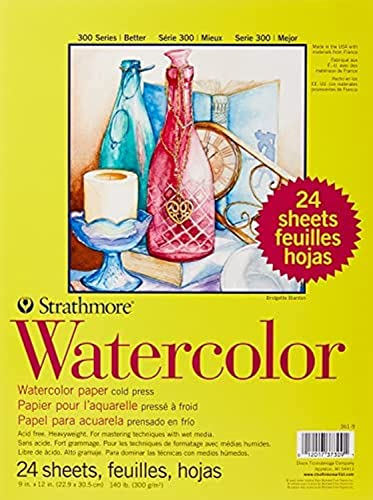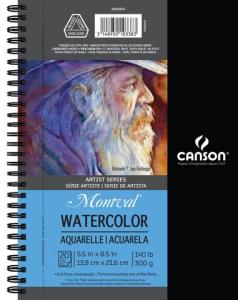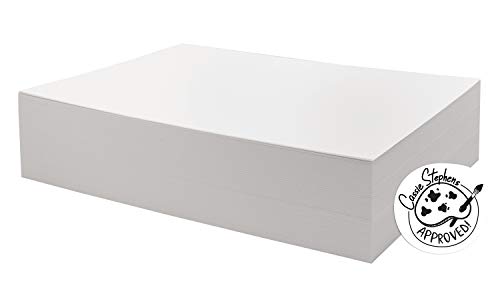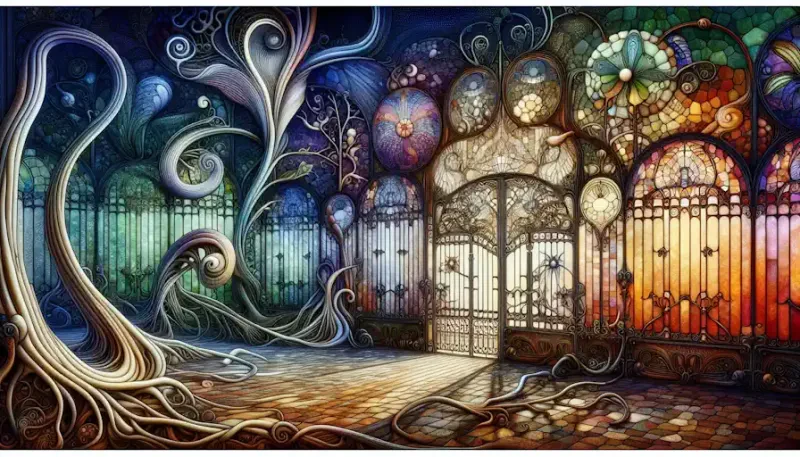Introduction
Watercolor paper is the unsung hero of watercolor painting, often overlooked but undeniably essential to the creation of stunning artworks. It serves as the foundation upon which artists bring their visions to life, providing the necessary support and surface texture for the delicate interplay of water, pigment, and brush.
Watercolor Paper The Foundation of Watercolor Painting
Watercolor, unlike other painting mediums, relies on the inherent properties of the paper to achieve its unique effects. The absorbency, texture, and sizing of the paper significantly influence how colors blend and flow, ultimately shaping the final outcome of the artwork.
Understanding the Importance of Paper Quality
The quality of the paper can make or break a watercolor painting. Inferior paper may buckle or warp when wet, causing puddles of pigment to pool unevenly or creating unwanted textures. Conversely, high-quality watercolor paper offers the stability and absorbency needed to control the flow of paint and achieve precise, nuanced results.
Navigating the World of Watercolor Paper
With a multitude of options available, choosing the right watercolor paper can be daunting, especially for beginners. Factors such as paper weight, texture, and composition must be carefully considered to ensure compatibility with your painting style and desired aesthetic.
The Purpose of This Guide
The aim of this article is to demystify the world of watercolor paper and empower artists of all levels to make informed choices. By providing an in-depth exploration of the characteristics and considerations associated with watercolor paper, we hope to equip readers with the knowledge and confidence to select the perfect paper for their artistic endeavors.
What to Expect
In the sections that follow, we will delve into the various aspects of watercolor paper, including its types, weights, textures, and sizing. Each section will offer valuable insights and practical advice to help you navigate the vast array of options and find the ideal paper to unleash your creativity.
Watercolor paper is much more than just a surface to paint on; it is a fundamental component of the artistic process. By understanding its importance and characteristics, you can elevate your watercolor paintings to new heights, unlocking a world of possibilities and creative expression. Join us as we embark on a journey through the intricate world of watercolor paper, where every brushstroke tells a story and every sheet holds the potential for masterpiece.
Understanding Watercolor Paper
Watercolor paper is not just any paper; it's specifically designed to accommodate the unique demands of watercolor painting. In this section, we'll delve deeper into what makes watercolor paper distinct, examining its composition, characteristics, and the different types available.
Definition and Composition
Watercolor paper is typically made from cellulose fibers derived from cotton, wood pulp, or a combination of both. These fibers are specially formulated to withstand the absorption of water without disintegrating or warping excessively. The composition of watercolor paper varies depending on the manufacturer and the intended quality of the paper, with premium papers often containing a higher percentage of cotton fibers for enhanced durability and longevity.
Characteristics of Watercolor Paper
Absorbency: One of the defining characteristics of watercolor paper is its ability to absorb water and pigment without deteriorating or becoming saturated. This absorbency allows for controlled layering and blending of colors, enabling artists to achieve rich, translucent washes and subtle gradations of tone.
Texture: Watercolor paper comes in a variety of textures, ranging from smooth to rough. The texture of the paper affects how paint is applied and how it interacts with the surface, influencing the overall appearance and feel of the artwork.
Sizing: Sizing refers to the treatment applied to the surface of the paper to control its absorbency. Sizing can be internal (incorporated into the paper fibers) or external (applied to the surface). Proper sizing prevents the paper from buckling or warping excessively when wet, ensuring a smooth painting surface and allowing for finer details and techniques.
Types of Watercolor Paper
There are three main types of watercolor paper: hot press, cold press, and rough.
Hot Press: Hot press paper has a smooth surface and minimal texture, making it ideal for detailed work and techniques such as botanical illustration or fine line work.
Cold Press: Cold press paper has a slightly textured surface, often referred to as "tooth," which provides a good balance between absorbency and texture. It's the most commonly used type of watercolor paper, suitable for a wide range of painting styles and techniques.
Rough: Rough paper has a pronounced texture with visible bumps and irregularities, resulting in more pronounced brushstrokes and texture in the finished painting. It's favored by artists who prefer a more expressive, textured appearance in their work.
By understanding the composition and characteristics of watercolor paper, artists can make informed decisions when selecting the appropriate paper for their specific needs and preferences. In the following sections, we'll explore the different types of watercolor paper in more detail, discussing their respective advantages, disadvantages, and ideal uses.
Importance of Paper Quality in Watercolor Painting
The quality of watercolor paper plays a pivotal role in the success of a painting. In this section, we'll delve into the significance of paper quality and how it can impact the overall outcome of your artwork.
Influence on Paint Application
Absorbency Control: High-quality watercolor paper is engineered to regulate the absorption of water and pigment, allowing for precise control over paint application. This ensures that colors remain vibrant and transparent, with minimal risk of muddying or bleeding.
Smooth Surface: Premium papers offer a smooth, uniform surface that promotes even paint distribution and crisp brushstrokes. This facilitates the execution of intricate details and fine lines, enhancing the overall clarity and definition of the painting.
Stability and Durability
Structural Integrity: Superior watercolor paper possesses the structural integrity to withstand multiple layers of paint without buckling or warping. This stability is essential for building up rich, layered washes and achieving depth and complexity in your paintings.
Longevity: High-quality paper is archival-grade, meaning it is acid-free and lignin-free, ensuring the longevity of your artwork. It resists yellowing, fading, and deterioration over time, preserving the vibrancy and integrity of your paintings for years to come.
Enhancing Visual Appeal
Surface Texture: The texture of the paper contributes to the visual appeal and character of the artwork. Whether smooth, textured, or rough, the surface texture of the paper adds depth and dimension to the painting, enhancing its tactile and visual interest.
Subtle Effects: Premium papers allow for the subtle manipulation of water and pigment, enabling artists to achieve a wide range of effects, from delicate washes to bold impasto. This versatility opens up endless creative possibilities and adds richness and complexity to your paintings.
Overall Impact on Artistic Expression
Confidence and Creativity: Painting on high-quality watercolor paper instills confidence in the artist, knowing that the paper will respond predictably and reliably to their techniques. This sense of assurance encourages experimentation and creative exploration, fostering artistic growth and innovation.
Professional Presentation: The use of premium watercolor paper elevates the overall presentation of your artwork, signaling to viewers that you are serious about your craft and committed to achieving the highest standards of quality and excellence.
In summary, the quality of watercolor paper is paramount in determining the success and longevity of your paintings. Investing in premium paper not only enhances the technical aspects of your artwork but also elevates its aesthetic appeal and professional presentation. In the following sections, we'll delve deeper into the various types of watercolor paper available, helping you choose the perfect paper to bring your artistic vision to life.
Watercolor Paper Deep Dive
Watercolor paper comes in a variety of types, each offering unique characteristics that cater to different artistic preferences and techniques. In this section, we'll explore the three main types of watercolor paper: hot press, cold press, and rough, discussing their respective attributes, advantages, and ideal uses.
Hot Press Paper
Characteristics: Hot press paper features a smooth, almost glassy surface with minimal texture. It is created by pressing the paper between heated rollers during the manufacturing process, resulting in a sleek, uniform finish.
Advantages
Smooth Surface: The smooth surface of hot press paper is ideal for detailed work and techniques that require precision, such as botanical illustration, architectural rendering, and portrait painting.
Fine Details: The lack of texture allows for the creation of crisp, precise lines and smooth gradients, making it well-suited for intricate designs and realistic renderings.
Ideal Uses: Hot press paper is favored by artists who prefer a refined, controlled approach to watercolor painting. It is particularly well-suited for projects that demand intricate details, sharp edges, and a high level of realism.
Cold Press Paper
Characteristics: Cold press paper has a slightly textured surface, often referred to as "tooth," which provides a balance between absorbency and texture. It is the most commonly used type of watercolor paper, offering versatility and adaptability for a wide range of painting styles.
Advantages
Versatility: The medium texture of cold press paper makes it suitable for various painting techniques, from wet-on-wet washes to dry brushwork. It offers enough tooth to hold pigment while still allowing for smooth color transitions and subtle blending.
Texture Variation: The surface texture of cold press paper adds visual interest and character to the artwork, lending a sense of depth and dimension to the finished piece.
Ideal Uses: Cold press paper is preferred by artists of all levels for its versatility and adaptability. It is well-suited for landscapes, still lifes, and expressive, painterly styles where texture and spontaneity are desired.
Rough Paper
Characteristics: Rough paper has a pronounced texture with visible bumps and irregularities, resulting in more pronounced brushstrokes and texture in the finished painting. It offers a tactile surface that adds visual interest and character to the artwork.
Advantages
Expressive Texture: The rough surface of the paper creates bold, expressive brushstrokes and texture effects, adding dynamism and energy to the painting.
Atmospheric Effects: The texture of rough paper lends itself well to capturing the essence of natural scenes, such as landscapes, seascapes, and atmospheric effects like clouds and foliage.
Ideal Uses: Rough paper is favored by artists who enjoy working with bold, gestural brushwork and expressive techniques. It is particularly well-suited for loose, impressionistic styles and paintings that evoke a sense of texture and movement.
By understanding the characteristics and ideal uses of each type of watercolor paper, artists can select the most suitable option to achieve their desired artistic effects. Experimenting with different papers allows for creative exploration and personal expression, ultimately enhancing the depth and diversity of your watercolor paintings.
Paper Weight and Thickness
In watercolor painting, the weight and thickness of the paper significantly influence its performance and suitability for various techniques. In this section, we'll explore the concept of paper weight, its implications for watercolor painting, and how to choose the right weight for your artistic needs.
Understanding Paper Weight
Definition: Paper weight refers to the thickness and density of the paper, typically measured in pounds (lb) or grams per square meter (gsm). The weight of watercolor paper can range from lightweight (90 lb or 190 gsm) to heavyweight (300 lb or 640 gsm) and beyond.
Significance: The weight of the paper affects its durability, absorbency, and handling characteristics. Heavier papers are more robust and less prone to buckling or warping when wet, while lighter papers may require stretching or mounting to prevent distortion.
Importance of Paper Weight in Watercolor Painting
Stability: Heavier papers offer greater stability and resilience, providing a sturdy foundation for multiple layers of paint and washes. This allows artists to work more freely without worrying about the paper buckling or becoming misshapen.
Absorbency: The weight of the paper influences its absorbency, with heavier papers generally having a higher capacity to hold water and pigment. This can affect the behavior of the paint, allowing for more controlled blending and layering of colors.
Handling Characteristics: Lighter papers may be more prone to tearing or damage during painting, particularly if they are repeatedly wetted and worked over. Heavier papers offer better handling characteristics, allowing for smoother paint application and finer details.
Choosing the Right Paper Weight
Painting Style: Consider your preferred painting style and techniques when selecting the paper weight. If you primarily work with wet-on-wet washes and heavy applications of paint, a heavyweight paper may be more suitable. For detailed work and dry brush techniques, a lighter weight paper may suffice.
Surface Texture: Keep in mind that the weight of the paper can influence its surface texture. Heavier papers may have a smoother surface, while lighter papers may exhibit more pronounced texture. Choose a weight that complements the desired texture and aesthetic of your artwork.
Experimentation: Don't be afraid to experiment with different paper weights to find what works best for you. Test how different weights respond to your painting techniques and preferences, and use this knowledge to inform your future paper choices.
By understanding the importance of paper weight and considering factors such as painting style, surface texture, and personal preferences, artists can choose the right paper weight to enhance their watercolor painting experience and achieve optimal results. In the next section, we'll explore the impact of paper texture and surface on the appearance and character of the artwork.
Paper Texture and Surface
The texture and surface of watercolor paper play a crucial role in dictating the visual and tactile qualities of a painting. In this section, we'll delve into the significance of paper texture, the different types of surface textures available, and how to select the right texture to enhance your artistic expression.
Understanding Paper Texture
Definition: Paper texture refers to the physical characteristics of the paper's surface, including its smoothness, roughness, or tooth. Texture influences how paint is absorbed and distributed on the paper, as well as the overall appearance and feel of the artwork.
Impact on Painting: The texture of the paper can dramatically affect the way colors interact, creating unique visual effects and adding depth and dimension to the painting. Artists often choose paper textures based on their preferred painting style and desired aesthetic.
Types of Paper Texture
Smooth: Smooth paper has a sleek, uniform surface with minimal texture. It provides a pristine, polished finish that is well-suited for detailed work and techniques that require precise control, such as botanical illustration or intricate line work.
Medium: Medium-textured paper, also known as "cold press," has a slight tooth that offers a balance between absorbency and texture. It provides enough tooth to hold pigment while still allowing for smooth color transitions and subtle blending, making it versatile for a wide range of painting styles.
Rough: Rough paper has a pronounced texture with visible bumps and irregularities. It creates bold, expressive brushstrokes and texture effects, adding dynamism and energy to the painting. Rough paper is favored by artists who enjoy working with gestural brushwork and expressive techniques.
Selecting the Right Texture
Painting Style: Consider your painting style and techniques when choosing the paper texture. If you prefer detailed, precise work, smooth paper may be more suitable. For loose, expressive styles, rough paper can add texture and visual interest to your paintings.
Subject Matter: Think about the subject matter of your artwork and how the paper texture can enhance its visual impact. For natural scenes like landscapes or seascapes, rough paper may evoke the texture of rocks, foliage, or water, adding authenticity and depth to the painting.
Personal Preference: Ultimately, the choice of paper texture is a matter of personal preference and artistic expression. Experiment with different textures to discover which one best suits your creative vision and resonates with your aesthetic sensibilities.
By understanding the significance of paper texture and considering factors such as painting style, subject matter, and personal preference, artists can choose the right texture to enhance the visual and tactile qualities of their watercolor paintings. In the following section, we'll explore the role of sizing and absorbency in controlling the behavior of watercolor paper.
Sizing and Absorbency
Sizing and absorbency are essential characteristics of watercolor paper that significantly influence how the paper interacts with water and pigment. In this section, we'll delve into the concept of sizing, its impact on paper absorbency, and how to choose the right level of sizing to control the behavior of your watercolor paper.
Understanding Sizing
Definition: Sizing refers to the treatment applied to the surface of the paper to control its absorbency. Sizing can be internal, meaning it is incorporated into the paper fibers during manufacturing, or external, where a surface treatment is applied after the paper is made.
Purpose: The primary function of sizing is to prevent the paper from absorbing too much water and pigment, which can lead to buckling, warping, and loss of color intensity. Sizing also facilitates the application of paint by allowing colors to flow smoothly and evenly across the surface.
Types of Sizing
Internal Sizing: Internal sizing is added to the paper pulp during the manufacturing process. It coats the individual fibers of the paper, reducing their ability to absorb water and pigment. Internal sizing helps maintain the structural integrity of the paper and prevents excessive swelling or distortion when wet.
External Sizing: External sizing is applied to the surface of the paper after it is made. It forms a protective barrier that seals the paper and reduces its absorbency. External sizing can be added to watercolor paper through various methods, such as dipping, spraying, or brushing.
Impact on Paper Absorbency
Controlled Absorption: Proper sizing allows the paper to absorb water and pigment at a controlled rate, ensuring consistent color saturation and washes. This enables artists to achieve smooth, even paint application and precise control over the flow of colors.
Lifting and Corrections: Sizing also affects the paper's ability to lift and rework paint. Papers with minimal sizing may allow colors to lift more easily, whereas heavily sized papers may resist lifting and require more effort to make corrections.
Choosing the Right Sizing
Painting Technique: Consider your preferred painting techniques and how they may be influenced by the paper sizing. For wet-in-wet techniques or heavily layered washes, a paper with moderate sizing may be preferable to allow colors to blend seamlessly. For detailed work or dry brush techniques, a paper with minimal sizing may offer more control and precision.
Personal Preference: Experiment with papers of different sizing levels to find what works best for your artistic style and preferences. Some artists may prefer papers with heavier sizing for their durability and resistance to warping, while others may favor papers with lighter sizing for their absorbency and ease of paint application.
By understanding the role of sizing and absorbency in watercolor paper, artists can make informed choices when selecting paper for their paintings. Whether seeking optimal control for detailed work or embracing the spontaneity of wet-on-wet techniques, the right sizing can enhance the performance and versatility of your watercolor paper. In the final section, we'll summarize key points discussed in this guide and offer recommendations for choosing the best watercolor paper for your artistic needs.
Watercolor Paper
In the journey of watercolor painting, the choice of paper is not merely a matter of practicality but an integral part of artistic expression. Throughout this guide, we've explored the intricacies of watercolor paper, from its composition and characteristics to its various types and considerations for selection. As we conclude, let's recap the key points discussed and offer some final thoughts on choosing the best watercolor paper for your artistic endeavors.
Summary of Key Points
Watercolor paper serves as the canvas for watercolor painting, influencing the behavior of water and pigment and ultimately shaping the outcome of the artwork.
Factors such as paper weight, texture, sizing, and absorbency play critical roles in determining the suitability of watercolor paper for different painting styles and techniques.
Understanding the characteristics and ideal uses of hot press, cold press, and rough paper can help artists make informed choices when selecting the most appropriate paper for their needs.
Paper weight and thickness affect the stability, absorbency, and handling characteristics of watercolor paper, while paper texture adds visual interest and dimension to the artwork.
Sizing and absorbency control the paper's interaction with water and pigment, influencing paint application, color saturation, and the ability to lift and rework paint.
Recommendations for Choosing Watercolor Paper
Consider your painting style, techniques, and preferences when selecting watercolor paper. Experiment with different types, weights, textures, and sizing levels to find what works best for you.
Invest in high-quality watercolor paper made from archival-grade materials to ensure the longevity and integrity of your artwork.
Be open to exploring new possibilities and pushing the boundaries of your creativity with different paper options. Embrace the unique characteristics of each paper type to enhance the visual and tactile qualities of your watercolor paintings.
Final Thoughts On Watercolor Paper
Watercolor paper is more than just a surface to paint on; it's a blank canvas waiting to be transformed into a work of art. By understanding its properties and selecting the right paper for your artistic vision, you can unlock endless possibilities and elevate your watercolor paintings to new heights of beauty and expression.
As you continue your artistic journey, may you find joy and inspiration in the rich textures and vibrant colors of watercolor paper, and may your paintings reflect the passion and creativity that reside within you. Happy painting!







